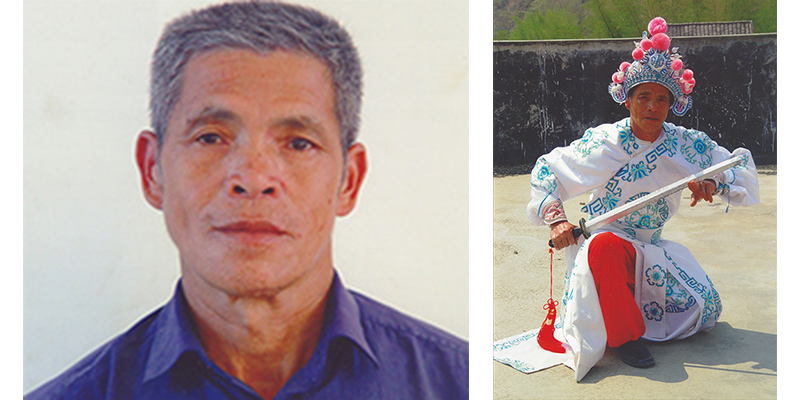
Nong Xueliang – Zhuang Opera Performer in Funing County, Wenshan
Nong Xueliang (农学良), male, of the Zhuang ethnic group, was born in 1949 in Houzhou Village, Guichao Town, Funing County, Wenshan Prefecture, Yunnan Province. He is a fifth-generation inheritor of Zhuang Opera in Funing. Passionate about Zhuang opera since childhood, he became an apprentice at the age of 15 to Gong Tianfu, an elder artist in his village, learning the vocal styles and performance techniques of Zhuang Opera. Through years of diligent practice, Nong Xueliang mastered not only performance but also directing and scriptwriting, becoming a versatile and accomplished opera artist.
Artistic Achievements
- Mastery of Zhuang Opera:
Nong Xueliang inherited and mastered the two major vocal styles of Yunnan Zhuang Opera — “Ai di nou” (哎的呶) and “Yi he hai” (依荷嗨) — and further developed them through performance and innovation. - Revival of the Opera Troupe:
In 1994, he led the revival of the Houzhou Opera Troupe, which had been inactive for eight years, and became its sixth-generation troupe leader (班主). - Mentorship and Transmission:
He placed great importance on passing on the tradition, recruiting many students and training two generations of successors, contributing significantly to the continuation and development of Zhuang Opera in Yunnan. - National-Level Recognition:
In December 2017, Nong Xueliang was officially recognized as a national representative inheritor of an item of intangible cultural heritage in the fifth batch of appointments.

Features of Zhuang Opera
-
Vocal Styles:
Zhuang Opera in Funing features four major vocal styles:
“Ai yi ya” (哎依呀), “Ai di nou” (哎的呶), “Guai hai lie” (乖嗨咧), and “Yi he hai” (依嗬嗨). -
Performance Style:
The performances are healthy, rustic, and lively in nature, with colorful music and unique techniques. The artistic expression is rich with ethnic flavor and distinctive local style. -
Repertoire:
The plays are mostly derived from Zhuang folk stories or Chinese historical legends, such as:
“Nong Zhigao” (侬智高), “Nong Ya King” (弄娅王), and “Snail Maiden” (螺蛳姑娘).
Inheritance and Preservation
-
Opera in Schools:
To protect and promote Zhuang Opera, Funing County has implemented initiatives such as bringing opera into schools, allowing the public to experience intangible cultural heritage up close. -
Cultivating Artistic Talent:
Since 2013, the local government has emphasized nurturing cultural talent, cultivating and guiding over 100 rural cultural teams, and assisting in the preparation of more than 200 cultural performances.
Legacy
As a representative inheritor of Zhuang Opera, Nong Xueliang has not only achieved artistic excellence but also made outstanding contributions to the preservation and transmission of this important form of intangible cultural heritage.
The Unique Performance Style of Zhuang Opera
Zhuang opera is a traditional theatrical art form created by the Zhuang people, characterized by a strong ethnic flavor. It is mainly popular in Zhuang-inhabited areas such as Guangxi and Yunnan. This form of opera blends Zhuang folk literature, music, dance, acrobatics, and other art forms, forming a distinctive performance style. The following are the main characteristics of Zhuang opera’s performance style:
1. Vocal Music
Rich vocal styles:
Zhuang opera features a wide variety of vocal styles, mainly categorized into “Ai de nou,” “Yi he hai,” “Guai hai lie,” and “Yi he hai.” Each vocal style has its own unique characteristics and functions:
- Ai de nou: Melodious and slow-paced, often used to express lyrical and narrative content.
- Yi he hai: Bright and lively in rhythm, typically used for joyful and festive scenes.
- Guai hai lie: High-pitched and intense, often used to convey passionate and heroic emotions.
- Yi he hai: Graceful and steady in rhythm, suitable for expressing delicate and affectionate content.
Accompaniment instruments:
The main accompanying instruments in Zhuang opera include the erhu (two-stringed fiddle), sanxian (three-stringed lute), pointed flute, cowhide drum, large gong, and cymbals. These instruments not only enhance the musical expressiveness but also add a rich ethnic flavor.
2. Performance Style
Improvisational elements:
Zhuang opera performances are flexible and dynamic. Actors often perform improvisationally based on the plot and emotions, making the performances more vivid and natural.
Role types:
The roles in Zhuang opera are divided into Sheng (male lead), Dan (female role), Jing (painted face), and Chou (comic role), each with its own distinct performance characteristics:
- Sheng: Usually plays upright characters; performances are elegant and solemn.
- Dan: Female roles; performances are delicate and graceful.
- Jing: Characters with strong personalities and exaggerated appearances; performances are bold and unrestrained.
- Chou: Comic or witty characters; performances are humorous and playful.
Dance movements:
Zhuang opera integrates rich dance elements, often derived from Zhuang folk dances. These movements are highly expressive and ethnically distinctive. Performers frequently use props such as handkerchiefs, fans, knives, spears, and swords, enhancing the expressiveness through choreographed movements.
3. Repertoire Content
Diverse sources:
Zhuang opera covers a wide range of themes, drawing from Zhuang folk tales, historical legends, and myths. These stories reflect the lives and emotions of the Zhuang people and embody their cultural values.
Traditional plays:
Notable examples include “Nong Zhigao,” “Nong Ya Wang,” “Snail Girl,” and “Liu Sanjie.”
Modern plays:
In recent years, Zhuang opera has expanded to include contemporary themes reflecting modern life and social values, such as “The First Secretary” and “Flower of Happiness.”
Linguistic features:
The lyrics and dialogues are mostly performed in the Zhuang language, which strengthens the ethnic atmosphere and enhances audience engagement.
4. Stage Design
Simple yet elegant:
Zhuang opera stages are generally simple, with a focus on the actors’ performance and the music to create atmosphere.
Use of props:
Performers make frequent use of props like handkerchiefs, fans, knives, spears, and swords, which not only enrich the visual experience but also help in expressing emotions and actions more vividly.
5. Performance Traditions
Rituals:
Before the performance, Zhuang opera performers often hold sacrificial ceremonies to pray for a smooth show and the safety of the audience.
Opening and closing rituals:
Each performance typically starts with cheerful music and dance, and concludes with a song conveying blessings.
Strong audience interaction:
Zhuang opera performances often involve direct interaction with the audience, which fosters deeper engagement and participation.
Zhuang opera, with its rich ethnic charm and artistic value, plays an important role in cultural inheritance and community cohesion. Thanks to the tireless efforts of inheritors like Dai Zhengyi and Nong Xueliang, Zhuang opera continues to thrive in modern society, standing as a cultural treasure in the grand tapestry of Chinese traditional arts.
For Chinese version please go to:
http://www.ynich.cn/view-ml-13111-3380.html

 7 Days GolfingTour
7 Days GolfingTour
 8 Days Group Tour
8 Days Group Tour
 8 Days Yunnan Tour
8 Days Yunnan Tour
 7 Days Shangri La Hiking
7 Days Shangri La Hiking
 11 Days Yunnan Tour
11 Days Yunnan Tour
 6 Days Yuanyang Terraces
6 Days Yuanyang Terraces
 11 Days Yunnan Tour
11 Days Yunnan Tour
 8 Days South Yunnan
8 Days South Yunnan
 7 Days Tea Tour
7 Days Tea Tour
 8 Days Muslim Tour
8 Days Muslim Tour
 12 Days Self-Driving
12 Days Self-Driving
 4 Days Haba Climbing
4 Days Haba Climbing
 Tiger Leaping Gorge
Tiger Leaping Gorge
 Stone Forest
Stone Forest
 Yunnan-Tibet
Yunnan-Tibet
 Hani Rice Terraces
Hani Rice Terraces
 Kunming
Kunming
 Lijiang
Lijiang
 Shangri-la
Shangri-la
 Dali
Dali
 XishuangBanna
XishuangBanna
 Honghe
Honghe
 Kunming
Kunming
 Lijiang
Lijiang
 Shangri-la
Shangri-la
 Yuanyang Rice Terraces
Yuanyang Rice Terraces
 Nujiang
Nujiang
 XishuangBanna
XishuangBanna
 Spring City Golf
Spring City Golf
 Snow Mountain Golf
Snow Mountain Golf
 Stone Mountain Golf
Stone Mountain Golf

















